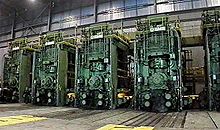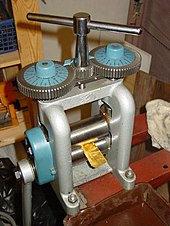
Rolling Mills
A rolling mill, also known as a reduction mill or mill, has a common construction independent of the specific type of rolling being performed:
- Work rolls
- Backup rolls – are intended to provide rigid support required by the working rolls to prevent bending under the rolling load
- Rolling balance system – to ensure that the upper work and back up rolls are maintained in proper position relative to lower rolls
- Roll changing devices – use of an overhead crane and a unit designed to attach to the neck of the roll to be removed from or inserted into the mill.
- Mill protection devices – to ensure that forces applied to the backup roll chocks are not of such a magnitude to fracture the roll necks or damage the mill housing
- Roll cooling and lubrication systems
- Pinions – gears to divide power between the two spindles, rotating them at the same speed but in different directions
- Gearing – to establish desired rolling speed
- Drive motors – rolling narrow foil product to thousands of horsepower
- Electrical controls – constant and variable voltages applied to the motors
- Coilers and uncoilers – to unroll and roll up coils of metal
Slabs are the feed material for hot strip mills or plate mills and blooms are rolled to billets in a billet mill or large sections in a structural mill. The output from a strip mill is coiled and, subsequently, used as the feed for a cold rolling mill or used directly by fabricators. Billets, for re-rolling, are subsequently rolled in either a merchant, bar or rod mill. Merchant or bar mills produce a variety of shaped products such as angles, channels, beams, rounds (long or coiled) and hexagons.
Configurations
Various rolling configurations. Key: A. 2-high B. 3-high C. 4-high D. 6-high E. 12-high cluster & F. 20-high Sendzimir Mill cluster
Mills are designed in different types of configurations, with the most basic being a two-high non-reversing, which means there are two rolls that only turn in one direction. The two-high reversing mill has rolls that can rotate in both directions, but the disadvantage is that the rolls must be stopped, reversed, and then brought back up to rolling speed between each pass. To resolve this, the three-high mill was invented, which uses three rolls that rotate in one direction; the metal is fed through two of the rolls and then returned through the other pair. The disadvantage to this system is the workpiece must be lifted and lowered using an elevator. All of these mills are usually used for primary rolling and the roll diameters range from 60 to 140 cm (24 to 55 in).
To minimize the roll diameter a four-high or cluster mill is used. A small roll diameter is advantageous because less roll is in contact with the material, which results in a lower force and power requirement. The problem with a small roll is a reduction of stiffness, which is overcome using backup rolls. These backup rolls are larger and contact the back side of the smaller rolls. A four-high mill has four rolls, two small and two large. A cluster mill has more than 4 rolls, usually in three tiers. These types of mills are commonly used to hot roll wide plates, most cold rolling applications, and to roll foils.
Historically mills were classified by the product produced:
- Blooming, cogging and slabbing mills, being the preparatory mills to rolling finished rails, shapes or plates, respectively. If reversing, they are from 34 to 48 inches in diameter, and if three-high, from 28 to 42 inches in diameter.
- Billet mills, three-high, rolls from 24 to 32 inches in diameter, used for the further reduction of blooms down to 1.5×1.5-inch billets, being the nubpreparatory mills for the bar and rod
- Beam mills, three-high, rolls from 28 to 36 inches in diameter, for the production of heavy beams and channels 12 inches and over.
- Rail mills with rolls from 26 to 40 inches in diameter.
- Shape mills with rolls from 20 to 26 inches in diameter, for smaller sizes of beams and channels and other structural shapes.
- Merchant bar mills with rolls from 16 to 20 inches in diameter.
- Small merchant bar mills with finishing rolls from 8 to 16 inches in diameter, generally arranged with a larger size roughing stand.
- Rod and wire mills with finishing rolls from 8 to 12 inches in diameter, always arranged with larger size roughing stands.
- Hoop and cotton tie mills, similar to small merchant bar mills.
- Armour plate mills with rolls from 44 to 50 inches in diameter and 140 to 180-inch body.
- Plate mills with rolls from 28 to 44 inches in diameter.
- Sheet mills with rolls from 20 to 32 inches in diameter.
- Universal mills for the production of square-edged or so-called universal plates and various wide flanged shapes by a system of vertical and horizontal rolls.
Tandem mill
A tandem mill is a special type of modern rolling mill where rolling is done in one pass. In a traditional rolling mill rolling is done in several passes, but in tandem mill there are several stands (>=2 stands) and reductions take place successively. The number of stands ranges from 2 to 18. Tandem mills can be either of hot or cold rolling mill types.







